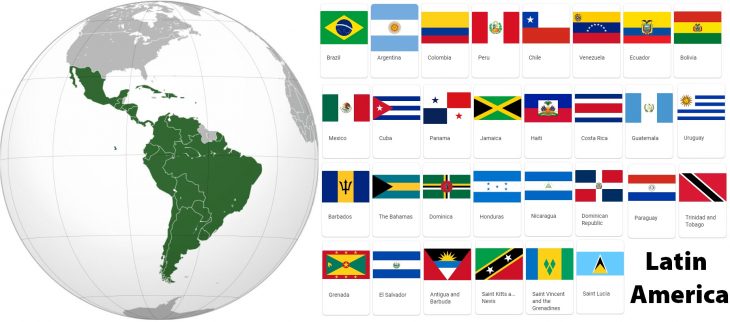List of Countries in Latin America
Latin America is a summary historical name of the countries of the American continent that have been under the influence of Spain, Portugal or France, and where Spanish, Portuguese or French are official languages. Geographically, Latin America encompasses most of South America, Central America, Mexico as well as some Caribbean islands. Most of the countries were colonized in the 16th centuries and became free during the early 1800’s. Linguistic unity is the clearest unifying factor, while Latin America expresses a variety of cultural and historical influences.
In other words, Latin America is a political and cultural term that serves to differentiate the Spanish and Portuguese-speaking countries of America from the English-speaking countries of America (Angloamerica).
How Many Countries in Latin America
In today’s common definition of the term, Latin America only includes those countries in which Spanish or Portuguese predominates. There are a total of 30 countries in Latin America. These include Mexico, Central America (excluding Belize), the Spanish-speaking areas of the Caribbean and the countries of South America (excluding Guyana, Suriname and French Guiana). The countries of Latin America together cover an area of around 20 million km² and the population is around 650 million people.
List of All Countries in Latin America
See the following table for full list of thirty Latin American countries in alphabetical order:
Map of Countries in Latin America
The part of word Latin refers to the Latin ical as the origin of Romanesque n languages. In the literal sense, countries and areas in which French are spoken also belong to Latin America. However, this understanding has not become generally accepted in the German-speaking area, but is used in the USA. The UN Statistics Division also subsumes all countries in Central America (including Mexico) and South America under the term Latin America. There are also other different definitions :
Other definitions of Latin America
- In the literal sense, Latin America also includes all French-speaking areas of America (and the Caribbean), which is also defined in the United States. According to this definition, the French-speaking Canadian province of Québec would theoretically also be part of Latin America. However, Québec is located in the middle of Anglo-America and is so closely intertwined with the Anglo-American cultural area that Québec is not counted as part of Latin America – neither is it part of Anglo-America because Québec is not English-speaking. The same applies to the Cajun s in Louisiana.
- Haiti, despite its French s official language by the common history and the border with the Dominican Republic closer ties to the Spanish and Portuguese speaking countries than other countries in the Caribbean. For this reason, it is sometimes included in Latin America even when the other French countries and territories are not included.
- Taking into account that in the Dutchareas Aruba, Bonaire and Curacao Papiamento, a Creole language with partly Romance roots, is spoken, some of these countries are included in the definition of Latin America.
- From the point of view of colonial history, the entire Caribbean is sometimes included in Latin America. In statistics of international organizations, however, it is usually shown separately (Latin America and the Caribbean).
- According to another definition used now and then in the US, Latin America refers to all American states south of the United States, including Belize, Jamaica, Barbados, Trinidad and Tobago, Guyana, Suriname, Antigua and Barbuda, Lucia, Dominica, Grenada, St. Vincent, St. Kitts and Nevis, the Grenadines and the Bahamas.
- In Brazil, the term “Latin America” is also used for Spanish-speaking America, similar to the use of the term “Europe” in the United Kingdom.
Latino and Latina
Latino or female Latina means a person of Latin American origin. This short form of the Spanish word Latinoamericano (“Latin American”) is mainly used in the Anglo-American area for US citizens who themselves or their ancestors come from Latin America and whose mother tongue is mostly Spanish or Portuguese. In the USA the term is often used synonymously to denote the group of Hispanics – however, Latinos are only part of the Hispanic population group in the USA, while the Brazilians living in the USA see themselves as Latinos, but not as Hispanics.
In a scientific sense, Latino only refers to Hispanics who immigrated from Central and South America, but not Spanish immigrants from Europe and their descendants. These are therefore Hispanics, but not Latinos. Conversely, Brazilians who immigrated to the USA are Latinos, but not Hispanics.












































































